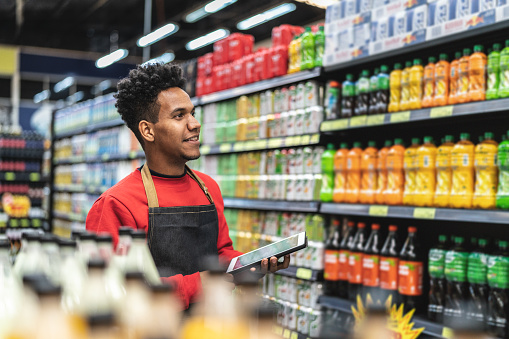IBM Cloud
Steve Laughlin Q&A: Retail Efficiency and Agility Via Hybrid Cloud
October 15, 2020
Early this year, IBM, along with several partners, launched Store in the Cloud, a suite of technologies built to function in an open, hybrid cloud architecture that brings together leading platforms like RedHat OpenShift, Sterling, Weather and Watson.
IBM’s Steve Laughlin, General Manager for Consumer Industry, explains how moving firmly to the cloud will help retailers innovate and thrive in a fiercely competitive and rapidly changing industry, while offering customers and employees a more efficient, seamless experience.

IBM's Store in the Cloud aims to make retail stores, and the people who work in them, more efficient than ever before.
What are some of the biggest pressures retailers are facing?
A year ago, we would have said retailers were under tremendous pressure because of rapidly changing customer expectations, the rise of innovative competitors and rapidly changing technology. And then the pandemic hit. And that, for a while, allowed governments to decide which retailers were essential.
But the reality is, as retailers in general reopened, it became clear that customers decide who’s essential. And the defining characteristic is differentiation—whether retailers stood out based on their product selection or the experience they created for their customers. Just as important is their ability to execute more efficiently in delivering those products and that experience, by streamlining operations and controlling costs. The pandemic has really raised the stakes and accelerated a Darwin-like shakeout that might have otherwise taken several more years to occur.
In fact, we are seeing consumer behaviors continue to shift as everyone in the industry figures out how to navigate the new world. This means that retailers will have to be even more agile than ever to quickly react to consumer demands.
What was the inspiration for Store in the Cloud?
For stores of any scale, the majority of applications that keep a store running smoothly sat on servers or computers onsite. Everyone always thinks of point-of-sale, but a retailer could have more than 100 applications related to labor, store management, receiving, supply chain, products and specific departments like pharmacy, photo, auto and customer service.
In recent years, a few clients started to look for more agile, innovative set-ups. For example, one was moving in-store applications to mobile devices like tablets, handheld devices and scanners to get more employees on the floor. Another client was finding it challenging to innovate because their applications all operated separately, in silos.

Steve Laughlin
It became clear that we needed an “app store in the cloud,” or a way that you could take a mobile device and have it work with an application portfolio and architecture in the cloud, versus having it sit in the store on a server. So, we’ve been working toward trying to enable a platform to bring together all these disparate applications, data sources and devices that can operate at the edge.
We helped create the last generation of store architecture and now, with an ecosystem of partners, we’re working to help create the next generation—using hybrid cloud.
Why hybrid cloud?
Hybrid cloud opens up retailers to the ease of building on what they have today. Stores operate in a hybrid multi-cloud environment, and this is a very complex ecosystem of devices, software and systems. We’re working with global systems integrators and encouraging software partners to join us. The complexity isn’t just from all the applications but also all the devices, especially given the proliferation of IoT devices— whether it’s something that measures the temperature of a refrigerator or meat counter, or counts customers coming in the door, or emerging technologies like electronic shelf labels and intelligent video analytics.
The need to manage that in an enterprise-grade, secure way is critical. You’re just not going to be able to do that at scale without the kinds of solutions that we’re taking to market. For a retail chain with hundreds, or even several thousand stores, it’s very hard to deploy new technology without the cloud because you’ve got to update a server, applications or multiple devices in those locations. With hybrid cloud, it’s more agile and quick, allowing retailers to react to market pressures or new complexities like buying online, or picking up in-store or curbside.
How will a hybrid cloud solution for retail help?
Roughly two thirds of the operating costs and working capital of a retailer is tied up in the store. So, anything you can do to make it more efficient is going to be materially beneficial.

Customers in a shop expect to have a digital experience, the same as they do online.
Take something like in-store cameras, which today are used for loss prevention. But you could start using intelligent video analytics to look at shelves and see open spaces that need to be restocked. Cameras with artificial intelligence could identify the missing product, locate it through the merchandise inventory system and send an alert to dispatch an employee to restock that shelf space through the labor management system. Across large store chains, the business case for doing that thousands of times a year would be a significant reduction in lost sales and a significant increase in revenue. Previously, that wouldn’t have been possible without tremendous expense, but in this scenario, it’s enabled through a platform in the hybrid cloud.
It will help employees as well. For instance, many grocers now have employees picking orders for customers who have ordered online. Those associates can have handhelds that use IoT devices to guide them to the right spot, which typically makes them 30 to 50 percent more efficient. That kind of innovation is key to driving efficiencies that result in either improved profit or reinvesting in the next innovation that results in a competitive advantage.
What will this mean for everyday consumers?
Consumers have high expectations from retailers and have come to expect a seamless and consistent experience whether online or in a physical shop. With cloud helping to link all the retailers’ tools together to drive new integration across both digital and physical shopping there will be a shift change in the consumer experience. Consumers will discover new more personalized experiences that meet their needs and provide new innovative capabilities. Further, with sustainability on many consumers’ minds, as supply chains become connect via blockchain technology, consumers will access detail about products, including their provenance and processing, creating consumer trust and loyalty.
So is brick-and-mortar not obsolete, as predicted?
I still believe the death of the store is an ill-advised prediction. Clearly, the pandemic accelerated the shift to online commerce for many customers. But the store still plays an important role in the buying journey for many customers.
I would also suggest that the segment of retail has much to do with the role of the store. The key point is for any given retailer to understand their customer, their customer’s buying journey and what role a physical place plays in their business model.
As I have long said, stores matter, but you have to make them matter. How they matter is different than how they have mattered for the last 40 years. And that’s the strategy and the secret sauce that each operator has to figure out.